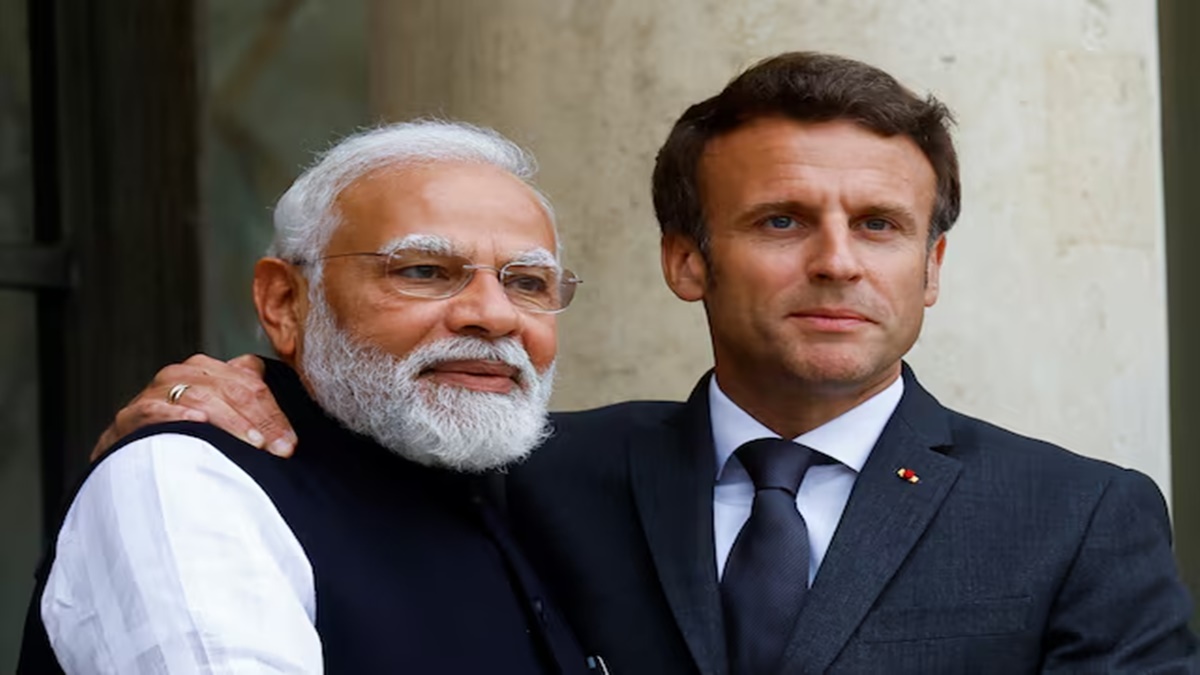By Jaya Dubey
Life is an intriguing web of patterns, a dynamic mix of squares, triangle,and circles. These patterns help us understand the various ways of human emotions, life with clarity and purpose. While reading about the February 2025 visit of our Prime Minister Narendra Modi to the US and France, a simple yet powerful idea struck me –can a triangle be imagined for concepts employed by him to balance various competing forces (Geopolitics, Viksit Bharat, and Net Zero) and be at the same time understood by a common person? Yes,it is possible, and that’s how the idea of the ‘Mod Angle’ was born- A triangle’s vertices to denote the competing force, sides to denote the interaction between them. Which is well balanced.
This visit had marked a significant shift towards reshaping the earlier unbalanced triangle (geopolitics, Viksit Bharat, and net zero) into a balanced ‘Mod Angle’, unlocking opportunities for India to pursue net-zero goals without undue pressure, aligning growth with sustainability and achieving a state of equilibrium as in ‘Mod Angle’ through his masterful geopolitics, exploiting Trump’s scepticism for climate change theories.
The transformation can be understood with the following points:
a). Geopolitics of emissions
The global north, under the Obama administration, put moral pressure on India and other developing nations to meet the stringent norms under the Paris Agreement 2015. However, they overlooked critical factors such as low per capita emissions (in 2022, India’s per capita CO₂ emissions were around 2 tonnes, less than half the global average of 4.7 tonnes), a large population, and late industrialisation. India argues that developed nations with higher historical emissions must lead mitigation under the common but differentiated responsibilities (CBDR) principle. These international arguments lead to strained geopolitical issues and impede the development goals of a growing economy like India.
However, Trump’s scepticism about climate change has changed the geopolitical dynamics and created a void in global climate leadership,which has reduced the overwhelming moral pressure on India and other developing nations to reduce carbon emissions. India can pursue its goal of renewable energy and net-zero more smoothly, efficiently, in a well-planned and sustainable way. It is quite evident from the fact that India had achieved two of its targets of Nationally Determined Contribution made in the Paris agreement – 2015, i). To reduce the emissions intensity of its GDP by 33 to 35% by 2030 from the 2005 level; ii). To achieve about 40% cumulative electric power installed capacity from non-fossil fuel-based energy resources by 2030, well ahead of time.
Additionally, the recent strategic meeting with the US laid the background for a $500 billion bilateral trade on oil/gas (LNG), defence technology (F-35 jets), etc, by 2030, up from $200 billion in FY24. Whereas, the Nuclear (SMRs), AI and infrastructure deal with France would be a stepping stone to Viksit Bharat’s $30 trillion target by 2047.
b) Economic growth for Viksit Bharat 2047
Viksit Bharat by 2047 is based on inclusive growth, industrialisation, self-reliance, infrastructure growth, while maintaining harmony with nature, powered by clean energy. As per the CEA and the ministry of power for FY24, electricity generation in India was around 1,843 terawatt-hours (TWh),with coal-fired power plants contributing 70% of the total. Achieving the status of a developed nation by 2047, India’s energy demand is projected to double by 2047, requiring around 800 gigawatts (GW) as compared to 470 GW in 2025. The status quo will create strain and make the triangle unbalanced,which needs transformation into a ‘Mod Angle’.
However, the recent visit strengthened the geopolitical position of India with developed nations and will allow more assertive development policies to achieve the ‘Viksit Bharat-2047’ vision. This diplomatic meeting would infuse the new technologies, for instance reducing the import tariffs on high technology products like high-end electric vehicles (EVs), computers, and GPUs, and announcing of $2.75 billion investment made by Micron to establish a semiconductor assembly and testing plant in Gujarat, will boost India’s role in the global chip supply chain, etc. This technological infusion and absorption is likely to improve the efficiency and productivity while consuming the less energy.
c) NetZero 2070
The rat race for economic growth without sustainable goals has resulted in a compromise on climate policies. Limited funding and a lack of green technology have hindered the large-scale adoption of renewable energy. Consequently, India’s environmental efforts are perceived as insufficient internationally, setting the stage for a blame game between the global north and the global south. In this scenario, these conflicting priorities result in an unbalanced triangle having sides of different lengths and angles of varying measures.
However, a recent deal with the US for the import of oil and gas allows decentralisation of energy sources. Civil Nuclear cooperations with France agree to add 9.6 GW of clean energy capacity, support 70 million homes, and reduction of over 50 million tons of CO₂ annually by building the world’s largest nuclear power plant in Jaitapur, Maharashtra. The green energy collaboration (Nuclear, Solar, etc), supports India’s Net Zero goals, economic progress, and enhances India’s leadership on the global stage of climate action.
Thus, Modi visit to the US, followed by the visits of the US CIA chief and the Vice President to India, laid the foundation for tariff negotiations and acted as an early opportunity to advance an ongoing trade deal with the US. It indicated that the efforts to balance trade has also contributed to balance other significant forces such as geopolitics, Viksit Bharat-2047, and Net Zero -2070. The cues from Indian actions have been embraced by other nations as a standard playbook. Meanwhile, the nuclear, AI, and infrastructure deal with France also supports the vision of Viksit Bharat. In short, many unbalanced triangle are evolving into a balanced ‘Mod Angle’.
(The author is an environmental scientist and public health professional)
Disclaimer: Views expressed are personal and do not reflect the official position or policy of FinancialExpress.com. Reproducing this content without permission is prohibited.

